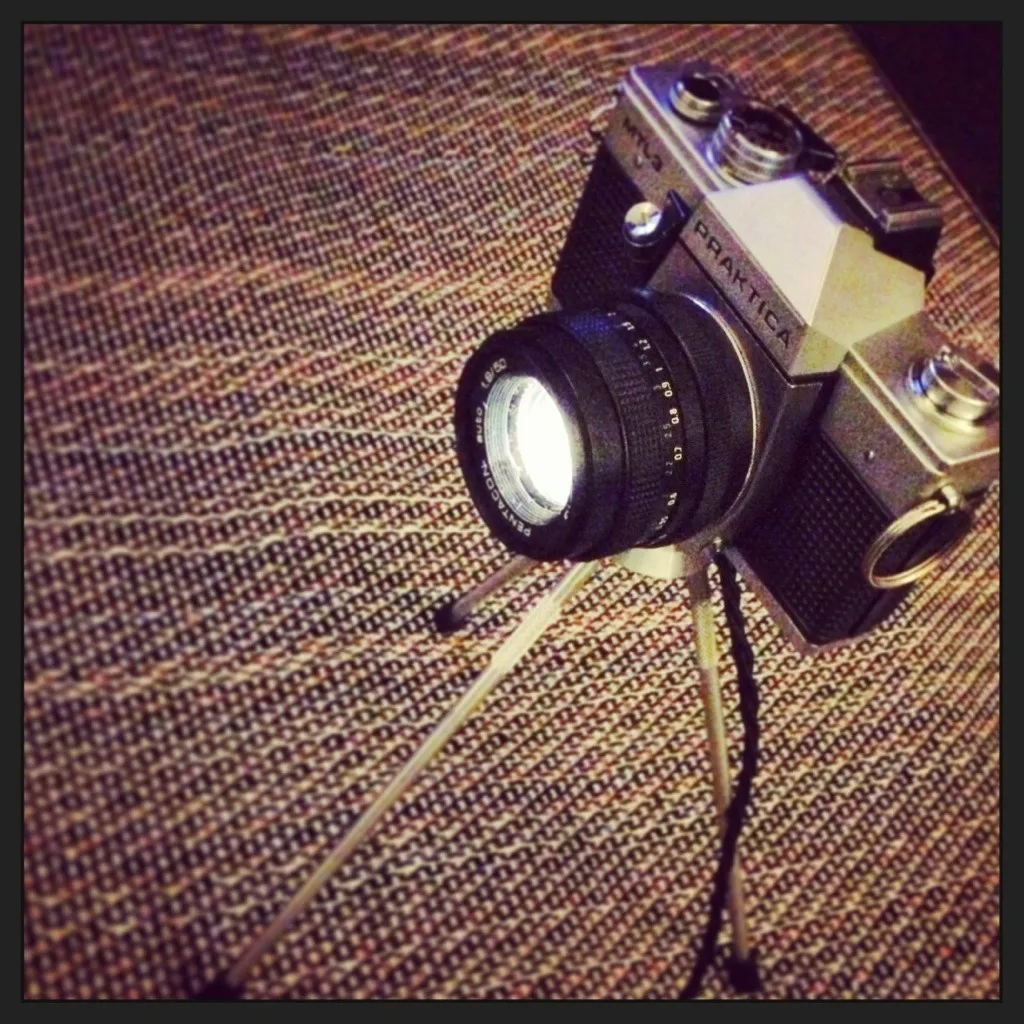How not to spend £300 on a cool lamp...
- 10/10
- Around £30.00
Practika Camera Desk Lamp...
I was sat in the departure lounge at London City Airport, bored and reading a well known Gadget Magazine (Stuff) when I came across a company (thedeaddollsclub.com) selling desk lamps made out of old cameras. At £300 I’ve got to be honest I was very tempted to hit the website and get one ordered, I love anything quirky like that and would go well with all of the other bits I’ve got in my apartment.
Something told me that day not to do it, maybe it was the superstrong Illy coffee that I’d been drining or maybe it was the fact that once I had landed in Edinburgh, that I had got a 2-3 hour drive back down to Leeds in a car that I knew wasn’t going to be comfortable. Either way, after seeing it! The inspiration bubbles were running through my head.
First thing I did was hit eBay! You want old non-working bits, then ebay is the place. Within 10 minutes I had bid on a number of different Practika camera in non-working condition for 99p, my next stop was antique two cord wire; if I wanted it to look like the one in the magazine I had to do it right!
I was then beginning to thing back about when I was young and all of the things we used to have in the house with dodgy plugs, I remember one word! Bakerlite! Next minute I was the successful Buy It Now bidder for 2 x Bakerlite plugs!
I didn’t really know what sort of bulb to put in the camera, so I text a good friend of mine who gave me some options. The one in the magazine was a halogen lamp, now I knew these ran on 12v. Which for a home project was much safer than putting 240v through a metal camera body.
I ordered some parts from a lamp supplier who had an outlet on eBay and these were already on the way to my house, by the time I had reached Edinburgh…
Creating the light...
Bear in mind now, that although I am a lover of gadgets. I only have a basic knowledge of electronics. But I can wire an electric plug which I am sure is quite an important thing to know in life. Blue, Brown and an Earth Wire What can go wrong!
The first cameras arrived (I say first as I won 10 all at 99p each), I used my watch screwdriver set to start to dismantle the camera. The screws were bloody small and I could not believe how many springs, levers and pieces of metal there were in these camera’s.
It was important to work out where the wire would feed up from and then where to place the light. Unlike the Tinker & Tailor Practika Desk Lamp, I wanted to be able to use the actual lens to change the way the light shone. So this would mean mounting the bulb behind the bayonet screw.
I used a 35w halogen light, the smaller type but still struggled with the wires. I delved deeper into the camera and smashed the mirror causing blood to pour from my finger! I’d also managed to bend the metal frame at the top of the camera. Unfortunately this camera had to go into the bin!
NEXT!… My next Camera to dismantle was a Practika MTL-3. This camera proved much easier to dismantle. I used the battery cover at the bottom as my feed into the base and inside of the camera. I then took as much of the internals out as possible so I could feed the window through the shutter curtains and towards the front of the camera.
The curtains are bloody sharp as well! Yet more blood appeared when I received a ‘paper’ cut from one of the twisted curtains, with a bit more aggression and a twist of the screwdriver it had come free and was in the trash.
Next job was to take the lens to bits, a few screws sorted this and I managed to twist the lens open and mount the bulb and fitting in place. I used some Wilkos connector blocks to wire the 2 together.
A trip to Ikea had solved the transformer problem, in the Bargain Basement was a transformer that pumped out a nice solid 12v ready for one of there lights. Unfortunately this meant I couldn’t use the bakerlite plugs but at least I was confident it would work.
I managed to get hold of an old style, fixed tripod from a local charity shop and twisted it onto the mount at the base of the camera. I screwed everything into place and apart from the metal casing at the base of the camera twisting slightly (this is visible from the back only) I was ready for the switch on.
LET THERE BE LIGHT… Yep I had actually done it, the lamp worked perfectly. I kept it on for a few hours to check temperature, etc but it operated without getting too hot.
Additional Information...
I would recommend having a go at this, it was fun. You will need a screwdriver set fit for a watchmaker/glasses person, the screws are fiddly and easy to lose. Couple of connector blocks and some of that gorgeous twin core wire that you used to find on antique lights.
Practika MTL-3 and MTL-5’s seem to be the most accessible for the wire, etc. Plus you can just about use any screw fit lens, I went for the damaged ones on ebay, quite a few lenses seem to get this fungus! They are the ones I went for.
Next time around I’m going to get myself some LED lights, hopefully the same size so that the heat of the unit itsn’t so high. Plus it will be more energy efficient.
I’m also hoping I haven’t started something here, as since I made the light I have had a couple of requests from people (mainly photographers) who are willing to pay a lot of money for them, and I’m talking £150 each! Which is half the price of the Tinker & Tailor version!
Saying that, apart from cutting my fingers in several places and spending 20 minutes fishing mirror glass out of my fingers and thumbs, I found the whole experience very therapeutic.
Have a go yourself and let me know how you got on with it, try a different design! I have ordered a couple of Cine Cameras to try something with and I am racking my brain to see what else is out
Disclaimer...
We haven’t been paid to write this review or make the camera, I just wanted one and wasn’t willing (and couldn’t afford) to pay the £300 out. So I made one. But… If you click on the links on this website, we may receive a small commission should you purchase anything.
What would go well with it...
Get yourself a nice lit glass cabinet, get yourself on eBay or down to the local flea markets and buy some broken old cameras.
Get them all out on display, a good friend of mine called Merv Spencer has done this and it looks Supadupa!
Update and Upgrade...
Since writing this article, I have changed the light to an LED bulb from a halogen. With the Halogen bulb the body of the camera got incredibly hot, the LED doesn’t give off as much heat and I feel the light colour and temperature is much nicer.


